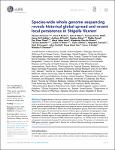Species-wide whole genome sequencing reveals historical global spread and recent local persistence in Shigella flexneri
Connor, Thomas R.
Barker, Clare R.
Baker, Kate S.
Weill, François-Xavier
Talukder, Kaisar Ali
Smith, Anthony M.
Baker, Stephen
Gouali, Malika
Thanh, Duy Pham
Azmi, Ishrat Jahan
Silveira, Wanderley Dias da
Semmler, Torsten
Wieler, Lothar H.
Jenkins, Claire
Cravioto, Alejandro
Faruque, Shah M.
Parkhill, Julian
Kim, Dong Wook
Keddy, Karen H.
Thomson, Nicholas R.
Shigella flexneri is the most common cause of bacterial dysentery in low-income countries. Despite this, S. flexneri remains largely unexplored from a genomic standpoint and is still described using a vocabulary based on serotyping reactions developed over half-a-century ago. Here we combine whole genome sequencing with geographical and temporal data to examine the natural history of the species. Our analysis subdivides S. flexneri into seven phylogenetic groups (PGs); each containing two-or-more serotypes and characterised by distinct virulence gene complement and geographic range. Within the S. flexneri PGs we identify geographically restricted sub-lineages that appear to have persistently colonised regions for many decades to over 100 years. Although we found abundant evidence of antimicrobial resistance (AMR) determinant acquisition, our dataset shows no evidence of subsequent intercontinental spread of antimicrobial resistant strains. The pattern of colonisation and AMR gene acquisition suggest that S. flexneri has a distinct life-cycle involving local persistence.
Dateien zu dieser Publikation
Keine Lizenzangabe

